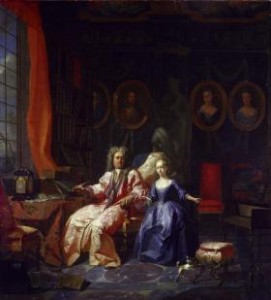
Believed to be a portrait of Francis and his daughter painted in 1721 by Flemish painter Jan Carel Vierpyl (National Gallery of Ireland)
Francis Hutchinson was born in Carsington, Derbyshire on the 2nd January 1660. He was the second son of Edward, a yeoman farmer, and Mary Tallents.
Francis matriculated as a pensioner on 4th July 1678 at Catherine Hall, Cambridge and graduated B.A. in 1680 and M.A in 1684. In July 1698 he started a Doctorate of Divinity. He was ordained Deacon in London on 23rd September 1683 and priest on 24th February 1683/4 and subsequently appointed lecturer at Widdington in Essex. He remained there until 1688 when he was presented to the rectory of Quendon in Essex. Whilst here he married Catherine and they had a son, Thomas, who was baptised on 12th July 1687.
In 1691 he resigned his post in Quendon to become vicar of Hoxne, being presented to the vicarage by William Maynard. He went on to have a daughter, Frances, who was born on 6th February and baptised on 13th February 1696. Unfortuately his wife, Catherine, died shortly after and was buried at Hoxne on 3rd March 1696. He later remarried Susanna/Susan whose death was recorded at Bury St. Edmunds however she was buried at Hoxne on 19th June 1712.
In early 1692 Francis was presented to the perpetual curacy of St. James' in Bury St. Edmunds and in 1706 he was instituted to the rectory of Passenham in the Diocese of Peterborough. This was when he had to give up his living at Hoxne, in accordance with canon law, although he was able to keep his curacy at Bury St. Edmunds.
Shortly after gaining his curacy in Bury St. Edmunds Francis bought property there and lived there for 28 years serving both Bury and Hoxne himself until 1697 when he began employing curates to serve in Hoxne.
Edmund Beeston, who was also rector of Sproughton, was employed as a full time curate for Hoxne. Francis' accounts record "Mr Beeston entered at Lady Day (25th March) 1697 and is to have £30 per annum for the time he supplies my cure." Edmund continued as curate until 26th October 1703 when he was replaced by John James who was subsequently replaced in 1706 by Edward Bosworth.
Meanwhile, in Bury St. Edmunds, Francis employed an assistant curate, Nathaniel Frith, who went on to become vicar of Hoxne after Francis in 1706.
Unlike his predecessor, Edward Willan, Francis was sceptical about witchcraft and went on to publish 'An Historical Essay concerning Witchcraft' in 1718.

In 1720, on the death of Edward Smith, Francis was appointed Bishop of Down and Connor in Ireland and was concecrated on 22nd January 1721. He moved to Lisburn, Co. Antrim and devoted himself to the work of the diocese. In 1729 he moved to Portlenone, Co. Antrim and built a chapel of ease at his own expense.
He died in 1739, aged 79, and was buried in Portglenone Parish Church, County Antrim.
A far more detailed account of his life and works can be found in a book by Andrew Sneddon - 'Witchcraft and Whiggs, The Life of Bishop Francis Hutchinson, 1660 - 1739' published by the Manchester University Press.